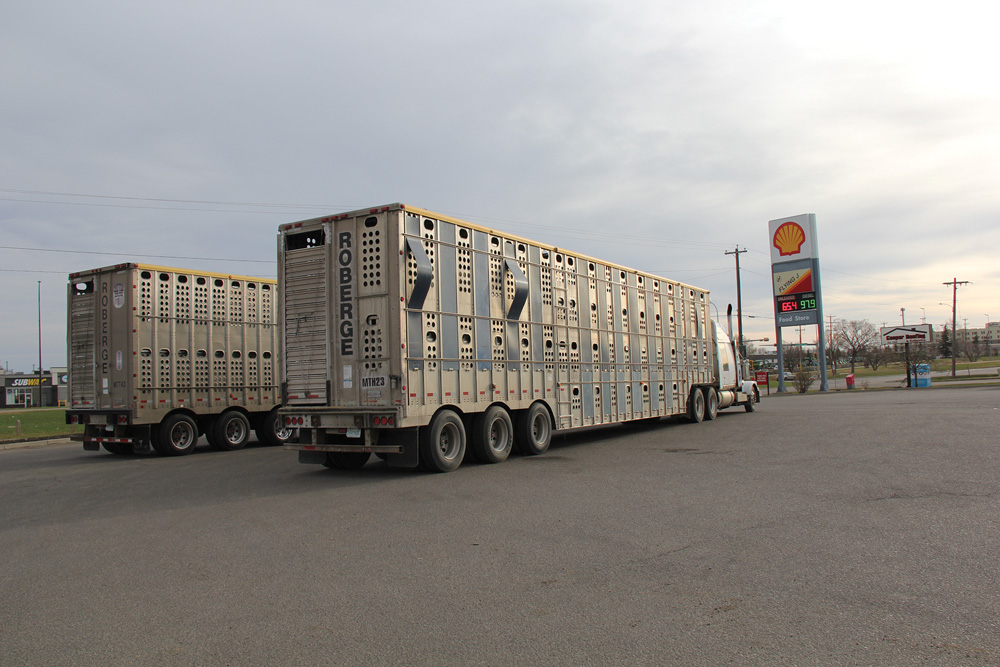Pacing the stage, Reg Schellenberg urged producers to take charge of the Transfer of Care issue, which will require more documentation from people hauling cattle near and far.
“If you take the lead as producers, you own it,” he says. “If the government takes the lead, they own it. We know what that’ll be like. They’ll just keep adding more and more to it.”
Schellenberg is president of the Canadian Cattle Association (CCA) and a rancher from Beechy, Sask. He was speaking at the Saskatchewan Stock Growers annual general meeting in Assiniboia, Sask., in early June. CCA has teamed up with the Livestock Market Association of Canada in asking the Canadian Food Inspection Agency (CFIA) for an exemption to the Transfer of Care (TOC) document requirements for short-haul cattle, he says.
Read Also

Treaty Land Sharing Network expands reach in Saskatchewan and Alberta
The Treaty Land Sharing Network, which connects land holders with First Nations and Metis people, has expanded since it began in 2018
Rick Wright, the executive assistant of the Livestock Markets Association of Canada (LMAC), has been working on the issue of TOC documents as well.
“It’s onerous because the responsibility for it has been put on the trucking industry and on the producers to provide the information. At the market level where we’re at, we’re not required to have the Transfer of Care document to receive the cow, because we don’t always have people on staff 24/7 when the cattle arrive.”
What is Transfer of Care?
CFIA’s website lists three requirements for TOC documents. They include the animals’ condition upon arrival; when the animals were last watered, fed and rested; and when the animals arrived at the slaughter establishment or assembly centre.
In 2019, the CFIA amended the Transfer of Care documents. They made four main changes, which involved categorizing animals fit for transport; record-keeping for transporters; required feed, water and rest times; and contingency planning. The CFIA also requires Transfer of Care documents to be filled out when taking livestock on a short haul.
At the time, the amendments were announced but not implemented. CFIA said they would use a two-year educational period to teach producers and other people in the industry about the changes that were made. However, Wright says this didn’t happen.
“One of the things that came up was during the two years between the change of the regulations and the hard enforcement of the regulations, there was supposed to have been an educational period in there,” he says. “And there was no education, especially for the primary producers. So there’s your confusion. Number one level is that the primary producers that shipped the majority of the cow to the intermediate sites, no one knew that this was coming. No one knew why it was coming. And no one knew what they were supposed to do with it. And there was very little input.”
Industry response
“When the changes were made — and that was over two years ago in February that they were made — we weren’t looking at Transfer of Care documents as an issue. We were so wrapped up in the amount of hours on the road — especially for the long-haul cattle that was being reduced down from 48 to 36 hours — that the industry put most of their resources into their comments and trying to persuade the government not to reduce those particular hours. It was an oversight on the industry’s part, that we should have looked at the fine print closer. We just didn’t think it was a big deal that was going to amount to anything. But now we’re past the soft launch.”
In tandem, LMAC and CCA have asked the CFIA for an exemption for the short-haul regulations.
“We have no argument with a Transfer of Care document in the event that there is a compromised animal on the load, or an animal arrives compromised due to something that’s happened during transportation,” Wright says. “But to have a general requirement to have a Transfer of Care document that comes with animals on short hauls (is the issue), and we’ve asked for an exemption of under 300 miles.”
At the Saskatchewan Stock Growers Association conference, Schellenberg talked about this as well, and spoke about the research the CCA has done on this topic.
“The health record or the success rate that we’ve got delivering cattle in those short hauls, we’ve probably got the best results that you can get,” he says, adding that “Ninety-nine per cent arrive in good condition. So we see no reason at all to justify the Transfer of Care being required for short haul.”
Schellenberg also shared part of a letter CCA and LMAC wrote together regarding the issue of short haul for the CFIA. According to Schellenberg, part of it reads: “This excellent track record suggests faster care process will not improve animal welfare outcomes for short haul. In very rare instances that negative welfare outcome will occur in short-haul cattle, durations of these risks are not the root causes of the problem.”
Wright says this change to the Transfer of Care documents is an issue because it causes unnecessary stress and work for the people who must handle the documents.
“If there is a compromised animal in the equation, well then it would trigger the need and use of a Transfer of Care document. So we’re asking for some common sense. This is overkill, is what it is.”
Wright says another issue is there is no standard form. While VBP Plus has a Transfer of Care form on its website for producers to use, CFIA doesn’t.
“There’s no CFIA, or government, form that the producers are required to fill out, that is the standard across the countryside,” he says. “But we’re part of the equation because the people that are being affected are our customers. And we will provide the information when the cattle are leaving our destination as to when they were last fed and watered.”
Wright says LMAC and CCA hope to meet with CFIA brass before the fall to make the case for an exemption and explain how the industry would handle an exemption.
“It’s very hard to change regulations once they’re in, but it’s the interpretation of the outcome. CFIA has a desired outcome, we have a desired outcome. And they’re both the same … Now maybe there’s some compromise there that we can get put together to make it easier. And that’s what we’re hoping. Will we see change this year? It’s hard to say,” says Wright.
Schellenberg says producers should step up and voice their opinions on the matter, as well, to help them prove their case to the CFIA.
“Timing is important,” he says. “With the federal government, decisions get made just like that and without warning. And I’m afraid if we sleep on this one, we’ll get bumped. That’s my input. It’s up to you as producers and voters to make that decision.”
CFIA responds
“This topic has been discussed by the joint Humane Transport Working Group for the cattle sector, which includes representatives from CFIA, AAFC, and industry. The group has discussed potential options to meet the (TOC) requirements, including partially pre-filled (TOC) documents for recurrent short hauls, the integration of the (TOC) information into livestock manifests or other documents/records already used by transporters and receivers. While there is no plan to amend the regulations, the CFIA continues to engage with industry and will consider solutions that are proposed to meet the (TOC) provision and the intent of the humane transport regulations.”
Although they are still in talks with the CFIA, Wright says they will continue to work to improve things for producers in the industry.
“I can tell you that industry is willing to step up anytime that it works and have a sit-down and try and work out something that will make life easier for these primary producers.”

















